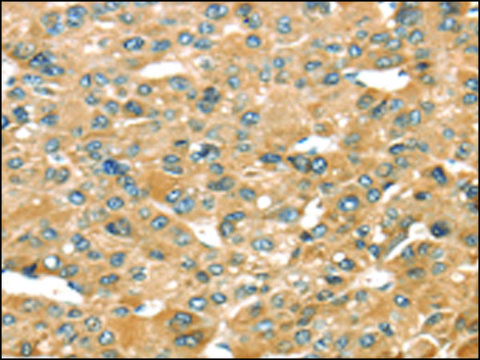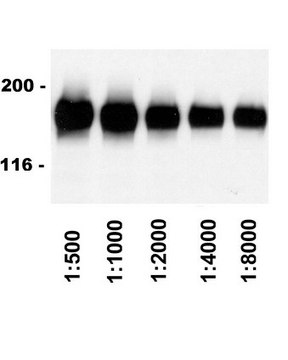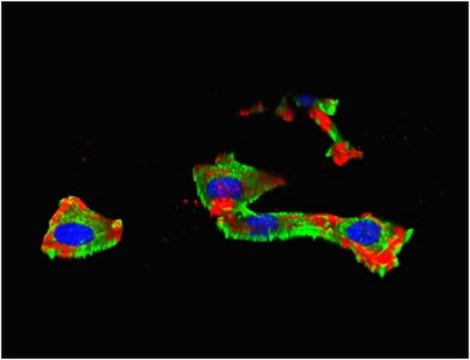71546
BacMagic Transfection Kit - Novagen
Sign Into View Organizational & Contract Pricing
Select a Size
100 μG
CA$696.00
Select a Size
Change View
100 μG
CA$696.00
About This Item
UNSPSC Code:
12352200
NACRES:
NA.54
Recommended Products
General description
The BacMagic-1 Transfection Kit provides a positive selection for creating baculovirus recombinants in preparation for recombinant protein expression in insect cells. The kit improves on the traditional method for generating recombinant baculoviruses by eliminating the tedious, time-consuming steps of plaque purification. BacMagic DNA is an AcNPV genome with a portion of the essential open reading frame (ORF) 1629 deleted, preventing nonrecombinant virus from replicating in insect cells. The target coding sequence in a compatible transfer plasmid, such as pIEx/Bac, pBAC, or pTriEx vectors, is cotransfected with BacMagic DNA into insect cells. Homologous recombination within the cells restores the function of the viral ORF1629. Only recombinant baculovirus can replicate, producing a homogeneous population of recombinants. The BacMagic-1 Transfection Kit contains the BacMagic-1 DNA, Insect GeneJuice® Transfection Reagent, and a positive control plasmid to monitor co-transfection efficiency. In addition, it contains Sf9 cells and BacVector Medium, for optimal transfection performance.
Components
- 0.5 µg : BacMagic DNA
- 50 µl : Insect GeneJuice® Transfection Reagent
- 2 x 1 ml : Sf9 Cells
- 1 L : BacVector Insect Cell Medium
- 2 µg L : Transfection Control Plasmid
Warning
Toxicity: Multiple Toxicity Values, refer to MSDS
Storage and Stability
Ship Code: Multiple Storage ConditionsStorage: Multiple storage requirements
Legal Information
GENEJUICE is a registered trademark of Merck KGaA, Darmstadt, Germany
NOVAGEN is a registered trademark of Merck KGaA, Darmstadt, Germany
Storage Class Code
10 - Combustible liquids
Certificates of Analysis (COA)
Search for Certificates of Analysis (COA) by entering the products Lot/Batch Number. Lot and Batch Numbers can be found on a product’s label following the words ‘Lot’ or ‘Batch’.
Need A Sample COA?
This is a sample Certificate of Analysis (COA) and may not represent a recently manufactured lot of this specific product.
Already Own This Product?
Find documentation for the products that you have recently purchased in the Document Library.
Mathilde Latil et al.
Nature communications, 3, 903-903 (2012-06-14)
The accessibility to stem cells from healthy or diseased individuals, and the maintenance of their potency are challenging issues for stem cell biology. Here we report the isolation of viable and functional skeletal myogenic cells from humans up to 17
Belén Mollá et al.
Disease models & mechanisms, 9(6), 647-657 (2016-04-16)
Frataxin (FXN) deficiency causes Friedreich's ataxia (FRDA), a multisystem disorder with neurological and non-neurological symptoms. FRDA pathophysiology combines developmental and degenerative processes of dorsal root ganglia (DRG), sensory nerves, dorsal columns and other central nervous structures. A dying-back mechanism has
Giulia Bertolin et al.
Autophagy, 9(11), 1801-1817 (2013-10-24)
Loss-of-function mutations in PARK2/PARKIN and PINK1 cause early-onset autosomal recessive Parkinson disease (PD). The cytosolic E3 ubiquitin-protein ligase PARK2 cooperates with the mitochondrial kinase PINK1 to maintain mitochondrial quality. A loss of mitochondrial transmembrane potential (ΔΨ) leads to the PINK1-dependent
Sven Dennerlein et al.
eLife, 10 (2022-01-01)
Human mitochondria express a genome that encodes thirteen core subunits of the oxidative phosphorylation system (OXPHOS). These proteins insert into the inner membrane co-translationally. Therefore, mitochondrial ribosomes engage with the OXA1L-insertase and membrane-associated proteins, which support membrane insertion of translation
Raul Guantes et al.
Genome research, 25(5), 633-644 (2015-03-25)
Noise in gene expression is a main determinant of phenotypic variability. Increasing experimental evidence suggests that genome-wide cellular constraints largely contribute to the heterogeneity observed in gene products. It is still unclear, however, which global factors affect gene expression noise
Our team of scientists has experience in all areas of research including Life Science, Material Science, Chemical Synthesis, Chromatography, Analytical and many others.
Contact Technical Service








